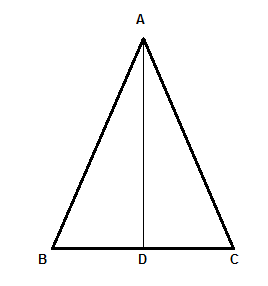
In an equilateral $\Delta ABC,AD\bot BC$. Prove that $A{{B}^{2}}+D{{C}^{2}}=\dfrac{5}{4}A{{C}^{2}}.$
Answer
604.5k+ views
Hint: Use the property that the altitude divides the triangle into two equal halves. Then use the Pythagoras theorem to both the triangles and hence find the relation between equations to get the desired results.
Complete step-by-step answer:
In the given question we are given an equilateral $\Delta ABC$ where a point D is specified on BC such that $AD\bot BC.$
So this means in the figure below, $\angle ADC=\angle ADB={{90}^{\circ }}$

At first we will write the properties of equilateral triangle which are as follows:
i) All the sides are equal.
ii) All the three internal angles are ${{60}^{\circ }}$ .
iii) The altitude, median, angle bisector and perpendicular bisector for each side are all in the same line.
Thus by the property (iii) of an equilateral triangle we can say that the point ‘D’ divides the sides BC into two equal halves.
So we can say that BD = DC.
As AD divides the equilateral $\Delta ABC$ in two congruent right angled triangles we can apply Pythagora's theorem to both parts of equilateral triangle.
So now by using Pythagoras theorem in $\Delta ADB$ we can say,
$A{{D}^{2}}+B{{D}^{2}}=A{{B}^{2}}..........\left( i \right)$
Similarly, by using Pythagoras theorem in $\Delta ADC$, we can say,
$A{{D}^{2}}+D{{C}^{2}}=A{{C}^{2}}..........\left( ii \right)$
BY moving $A{{D}^{2}}$ from left hand to right hand side in equation (ii) we can write it as,
$D{{C}^{2}}=A{{C}^{2}}-A{{D}^{2}}..........\left( iii \right)$
The equation (i) can be written as,
$A{{B}^{2}}=A{{D}^{2}}+B{{D}^{2}}..........\left( iv \right)$
So now adding (iii) and (iv) we get,
$A{{B}^{2}}+D{{C}^{2}}=A{{C}^{2}}+B{{D}^{2}}..........\left( v \right)$
Now by the property of equilateral triangle, that is all the sides are equal, we can say that,
AC = BC ………………(vi)
As we know that point ‘D’ divides ‘BC’ into two equal parts so we can write,
BC = 2BD ……………(vii)
Now in equation (vi) we can substitute the result of (vii) so now we can write it as,
AC = 2BD
Which can be further written as,
$BD=\dfrac{AC}{2}$
Now squaring on both the sides we get,
$B{{D}^{2}}=\dfrac{A{{C}^{2}}}{4}$
Now putting $B{{D}^{2}}=\dfrac{A{{C}^{2}}}{4}$ in equation (v) we get,
$\begin{align}
& A{{B}^{2}}+D{{C}^{2}}=A{{C}^{2}}+B{{D}^{2}} \\
& \Rightarrow A{{B}^{2}}+D{{C}^{2}}=A{{C}^{2}}+\dfrac{A{{C}^{2}}}{4} \\
\end{align}$
Hence we can write,
$A{{B}^{2}}+D{{C}^{2}}=\dfrac{5}{4}A{{C}^{2}}$
Hence proved
Note: Students generally stuck after reading to the equation $A{{B}^{2}}+D{{C}^{2}}=A{{C}^{2}}+B{{D}^{2}}.$
They generally forget to use the property that the altitude, median and angle bisector are aligned in the same line. So they should be careful about it.
Complete step-by-step answer:
In the given question we are given an equilateral $\Delta ABC$ where a point D is specified on BC such that $AD\bot BC.$
So this means in the figure below, $\angle ADC=\angle ADB={{90}^{\circ }}$

At first we will write the properties of equilateral triangle which are as follows:
i) All the sides are equal.
ii) All the three internal angles are ${{60}^{\circ }}$ .
iii) The altitude, median, angle bisector and perpendicular bisector for each side are all in the same line.
Thus by the property (iii) of an equilateral triangle we can say that the point ‘D’ divides the sides BC into two equal halves.
So we can say that BD = DC.
As AD divides the equilateral $\Delta ABC$ in two congruent right angled triangles we can apply Pythagora's theorem to both parts of equilateral triangle.
So now by using Pythagoras theorem in $\Delta ADB$ we can say,
$A{{D}^{2}}+B{{D}^{2}}=A{{B}^{2}}..........\left( i \right)$
Similarly, by using Pythagoras theorem in $\Delta ADC$, we can say,
$A{{D}^{2}}+D{{C}^{2}}=A{{C}^{2}}..........\left( ii \right)$
BY moving $A{{D}^{2}}$ from left hand to right hand side in equation (ii) we can write it as,
$D{{C}^{2}}=A{{C}^{2}}-A{{D}^{2}}..........\left( iii \right)$
The equation (i) can be written as,
$A{{B}^{2}}=A{{D}^{2}}+B{{D}^{2}}..........\left( iv \right)$
So now adding (iii) and (iv) we get,
$A{{B}^{2}}+D{{C}^{2}}=A{{C}^{2}}+B{{D}^{2}}..........\left( v \right)$
Now by the property of equilateral triangle, that is all the sides are equal, we can say that,
AC = BC ………………(vi)
As we know that point ‘D’ divides ‘BC’ into two equal parts so we can write,
BC = 2BD ……………(vii)
Now in equation (vi) we can substitute the result of (vii) so now we can write it as,
AC = 2BD
Which can be further written as,
$BD=\dfrac{AC}{2}$
Now squaring on both the sides we get,
$B{{D}^{2}}=\dfrac{A{{C}^{2}}}{4}$
Now putting $B{{D}^{2}}=\dfrac{A{{C}^{2}}}{4}$ in equation (v) we get,
$\begin{align}
& A{{B}^{2}}+D{{C}^{2}}=A{{C}^{2}}+B{{D}^{2}} \\
& \Rightarrow A{{B}^{2}}+D{{C}^{2}}=A{{C}^{2}}+\dfrac{A{{C}^{2}}}{4} \\
\end{align}$
Hence we can write,
$A{{B}^{2}}+D{{C}^{2}}=\dfrac{5}{4}A{{C}^{2}}$
Hence proved
Note: Students generally stuck after reading to the equation $A{{B}^{2}}+D{{C}^{2}}=A{{C}^{2}}+B{{D}^{2}}.$
They generally forget to use the property that the altitude, median and angle bisector are aligned in the same line. So they should be careful about it.
Recently Updated Pages
Master Class 12 Business Studies: Engaging Questions & Answers for Success

Master Class 12 Economics: Engaging Questions & Answers for Success

Master Class 12 English: Engaging Questions & Answers for Success

Master Class 12 Maths: Engaging Questions & Answers for Success

Master Class 12 Social Science: Engaging Questions & Answers for Success

Master Class 12 Chemistry: Engaging Questions & Answers for Success

Trending doubts
Write a letter to the principal requesting him to grant class 10 english CBSE

Why is there a time difference of about 5 hours between class 10 social science CBSE

What is the median of the first 10 natural numbers class 10 maths CBSE

The Equation xxx + 2 is Satisfied when x is Equal to Class 10 Maths

Discuss the main reasons for poverty in India

10 examples of evaporation in daily life with explanations




